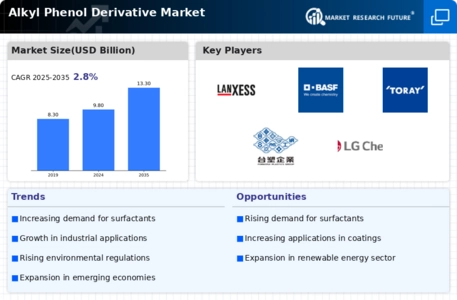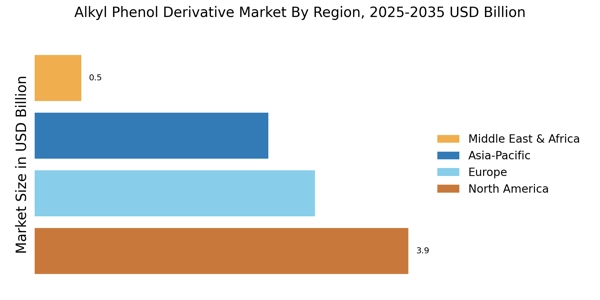Regulatory Frameworks and Compliance
The regulatory landscape surrounding chemical products is becoming increasingly stringent, which is influencing the Alkyl Phenol Derivative Market. Compliance with regulations regarding safety, health, and environmental standards is essential for manufacturers. As governments implement more rigorous guidelines, companies are compelled to adapt their production processes and product formulations to meet these requirements. This compliance not only ensures market access but also enhances brand reputation among consumers. The Alkyl Phenol Derivative Market is likely to see a shift towards more compliant and safer products, which could lead to increased market share for those companies that prioritize regulatory adherence.
Rising Demand in End-User Industries
The Alkyl Phenol Derivative Market is experiencing a notable surge in demand from various end-user sectors, including automotive, construction, and personal care. The automotive industry, in particular, is increasingly utilizing alkyl phenol derivatives in the production of adhesives and coatings, which are essential for vehicle assembly and durability. Additionally, the construction sector employs these derivatives in sealants and paints, contributing to the overall market growth. As of 2025, the demand from these industries is projected to increase by approximately 5% annually, indicating a robust market trajectory. This rising demand is likely to drive innovation and expansion within the Alkyl Phenol Derivative Market, as manufacturers seek to meet the evolving needs of their clients.
Growing Awareness of Environmental Impact
There is a growing awareness regarding the environmental impact of chemical products, which is influencing the Alkyl Phenol Derivative Market. Consumers and regulatory bodies are increasingly advocating for sustainable practices and eco-friendly alternatives. This shift is prompting manufacturers to invest in research and development to create greener alkyl phenol derivatives that minimize ecological footprints. The market is witnessing a gradual transition towards bio-based derivatives, which could potentially capture a significant share of the market by 2027. This trend not only aligns with The Alkyl Phenol Derivative Industry.
Expanding Applications in Emerging Markets
Emerging markets are presenting new opportunities for the Alkyl Phenol Derivative Market, as industrialization and urbanization continue to accelerate. Countries in Asia and Latin America are witnessing a rise in demand for alkyl phenol derivatives in various applications, including textiles, agriculture, and electronics. The increasing population and economic growth in these regions are driving the need for more advanced chemical products. By 2026, it is anticipated that the market in these emerging economies could grow by over 7%, significantly contributing to the overall expansion of the Alkyl Phenol Derivative Market. This trend suggests that companies focusing on these regions may benefit from enhanced sales and market penetration.
Technological Innovations in Production Processes
Technological advancements are playing a crucial role in shaping the Alkyl Phenol Derivative Market. Innovations in production processes, such as the development of more efficient catalytic methods, are enabling manufacturers to produce alkyl phenol derivatives with higher purity and lower energy consumption. These advancements are expected to reduce production costs and enhance product quality, thereby attracting more customers. As of October 2025, it is estimated that companies adopting these technologies could see a reduction in operational costs by up to 15%, which may significantly impact their market positioning. Consequently, the integration of advanced technologies is likely to bolster the growth of the Alkyl Phenol Derivative Market.


















Leave a Comment